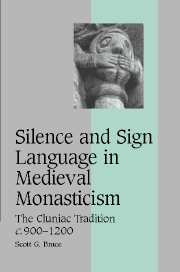Book contents
- Frontmatter
- Contents
- List of tables
- Acknowledgments
- List of abbreviations
- Map
- INTRODUCTION: THE DORMANT LANGUAGE
- 1 UTTERING NO HUMAN SOUND
- 2 THE TRAINING OF THE HAND
- 3 A SILENT COMMERCE OF SIGNS
- 4 TRANSMISSION AND ADAPTATION
- 5 CONTINUITY AND CRITICISM
- CONCLUSION
- Appendix A: The Cluniac sign lexicon
- Bibliography
- Index
- Cambridge Studies in Medieval Life and Thought Fourth Series
1 - UTTERING NO HUMAN SOUND
Published online by Cambridge University Press: 16 July 2009
- Frontmatter
- Contents
- List of tables
- Acknowledgments
- List of abbreviations
- Map
- INTRODUCTION: THE DORMANT LANGUAGE
- 1 UTTERING NO HUMAN SOUND
- 2 THE TRAINING OF THE HAND
- 3 A SILENT COMMERCE OF SIGNS
- 4 TRANSMISSION AND ADAPTATION
- 5 CONTINUITY AND CRITICISM
- CONCLUSION
- Appendix A: The Cluniac sign lexicon
- Bibliography
- Index
- Cambridge Studies in Medieval Life and Thought Fourth Series
Summary
Early medieval abbeys were alive with sound. The glorification of God through the celebration of the divine office was the primary activity of cloistered men and women, who intoned the psalms for the benefit of their souls and for the spiritual well-being of the entire Christian community. Like heavenly bees in their hives, monks were not silent in their industry. Their lips were always busy with the buzzing of prayer and praise. Yet in this sonorous environment, monks also esteemed the cultivation of silence as a saving virtue. Apart from their participation in devotional activities like the divine office, it was often forbidden for them to utter a sound. Silence emerged as an important aspect of monastic conduct in the earliest days of Christian asceticism, the first principle of which was the renunciation of the world in anticipation of the Last Judgment. As the great monastic historian Jean Leclercq observed: “All forms of asceticism – mortification, chastity, obedience, poverty – derive from this first idea of the total renunciation of everything that is not from God and to prepare for the total adherence, in the glory to come, of the soul and body of the redeemed to the one all-sufficient God.” Monastic silence did not entail the complete suppression of human speech, however, as the term implies in its modern sense.
- Type
- Chapter
- Information
- Silence and Sign Language in Medieval MonasticismThe Cluniac Tradition, c.900–1200, pp. 13 - 52Publisher: Cambridge University PressPrint publication year: 2007



